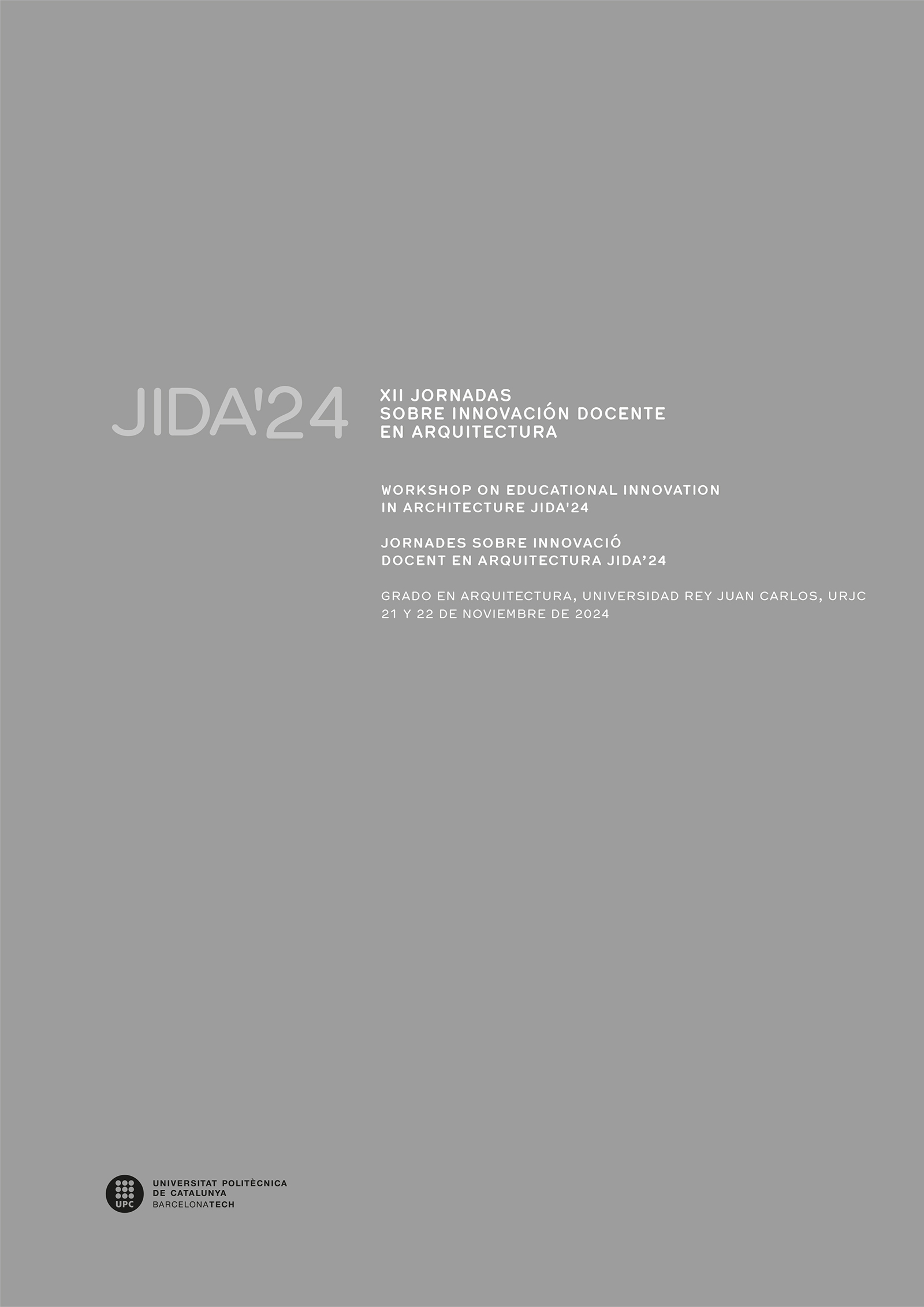Socially situated architectural pedagogies: a repository of tools and methods
DOI:
https://doi.org/10.5821/jida.2024.13282Keywords:
critical pedagogies, teaching-learning methods, teaching tools, agencyAbstract
Teaching in Schools of Architecture must adapt to the demands of the 21st century, connecting the teaching of this discipline with the physical, economic and social reality of our contemporaneity. The European project ‘Socially Situated Architectural Pedagogies’ (SArPe) investigates which analogue pedagogical tools facilitate this connection without losing their situated orientation after adaptation to the digital environment. To this end, the project develops an open repository of socially situated pedagogical methods and tools in Architecture.
References
American Psychological Association. «American Psychological Association Dictionary». Accedido 03 de mayo de 2023. https://dictionary.apa.org/open-classroom-method
Blasco, Silena y Lila Insúa. 2018. Programa sin Créditos en modo celebración. Relatos sobre comunidades artísticas de aprendizaje. Madrid: Ediciones Asimétricas.
Chamel, Olivier. 2016. «Design/build: a relevant pedagogy for architecture education», Vitruvio International Journal of Architectural Technology and Sustainability, 2016 (1): 53-65. doi: 10.4995/vitruvio-ijats.2016.6773
Colomina, Beatriz, Ignacio G. Galán, Evangelos Kotsioris y Anna-Maria Meister 2022. Radical pedagogies. Cambridge: MIT Press.
Crysler, Greig. 1995. «Critical Pedagogy and Architectural Education». Journal of Architectural Education, 1995 48 (4): 208-217. doi.org/10.2307/1425383
De Angelis, Massimo. 2003. «Reflections on Alternatives, Commons and Communities». The Commoner, 2003 (6): 1-14. https://thecommoner.org/back-issues/issue-06-winter-2003/
De Carlo, Giancarlo. 2015. L’architettura della partecipazione. Macerata: Quodlibet.
Demacio, Paula, Alissa Bigelow, Tricia Bonner y Shauna Roch. 2022. Extending Into the Open. Accedido 14 de junio de 2024. https://ecampusontario.pressbooks.pub/teachingintheopen/
Deplazes, Andrea, Oscar Linares de la Torre y Margarita Salmerón Espinosa. 2017. «Learning by building. Dos experiencias didácticas de la Cátedra Deplazes ETH-Z». En V Jornadas sobre Innovación Docente en Arquitectura (JIDA'17), Escuela Técnica Superior de Arquitectura de Sevilla. Iniciativa Digital Politècnica, 123-137. https://upcommons.upc.edu/bitstream/handle/2117/109588/5218-2965-1-PB.pdf?sequence=1&isAllowed=y
Dillenbourg, Pierre, Sanna Järvelä y Frank Fischer. 2009. «The evolution of research on computer-supported collaborative learning. From design to orchestration». En Technology-Enhanced Learning, editado por Arkendu Sen y Calvin K. C. Leong, 3-19. Netherlands: Springer.
Freire, Paulo. 1970. «Pedagogía del oprimido». Montevideo: Tierra Nueva.
Friedman, Yona. 1980. Toward a Scientific Architecture. Cambridge, Mass.: MIT Press.
Furco, Andrew. 1996. «Service-learning: a balanced approach to experiential education». En Expanding Boundaries: Serving and Learning, editado por Barbara Taylor y Corporation for National Service, 2-6. Washington DC: Corporation for National Service.
Guevara Álvarez, Oscar Ernesto. 2013. Análisis del proceso de enseñanza aprendizaje de la Disciplina Proyecto Arquitectónico, en la carrera de Arquitectura, en el contexto del aula. Tesis doctoral. Universitat Autònoma de Barcelona. https://www.educacion.gob.es/teseo/imprimirFicheroTesis.do?idFichero=F4G9xYsJh5c%3D
Haraway, Donna. 1988. «The science question in feminism as a site of discourse on the privilege of partial perspective». Feminist Studies, 1988 14 (3): 575-579. doi.org/10.2307/3178066
Higgins, Jackie. 2021. Sentient: What animals reveal about our senses. Londres: Pan Macmillan
Hooks, Bell. 1994. Teaching to transgress: Education as the practice of freedom. Nueva York: Routledge.
Johnson, David, Roger Jonhson y Edithe Holubec. (1999). El aprendizaje cooperativo en el aula. Buenos Aires: Paidos ibérica
Kandiko Howson, Camille. 2012. «Leadership and creativity in higher education: The role of interdisciplinarity». London Review of Education, 2012 10(2): 191-200. doi: 10.1080/14748460.2012.691283
Kolb, David. 1984. Experiential Learning: Experience As The Source Of Learning And Development. New Jersey: Prentice-Hall.
López Frasca, Stella, Federico Soriano Pelaez, y Ana Laura Castillo. 2022 «Superorganismo: mutaciones en el proceso proyectual». En X Jornadas sobre Innovación Docente en Arquitectura (JIDA’22), Escuela Técnica Superior de Arquitectura de Reus. Iniciativa Digital Politècnica, 741-51. https://doi.org/10.5821/jida.2022.11670
Mannion, Gregg. 2012. «Intergenerational Education: The Significance of Reciprocity and Place». Journal of Intergenerational Relationships, 2012 10(4): 386-399. doi: 10.1080/15350770.2012.726601
Mezirow, Jack. 1997. «Transformative Learning: Theory to Practice». New Directions for Adult and Continuing Education, 1997 (74): 5-12. doi: 10.1002/ace.7401
Montellano Tolosa, Carlos. 2003. Sala de Espejos Múltiples: Práctica Profesional Reflexiva del Taller de Proyectos Universidad Tecnológica Metropolitana. Santiago de Chile.
Moreira-Cedeño, José Alexander, Lubis Carmita Zambrano-Montes y María Rodríguez-Gámez. 2021. «El modelo Design thinking como estrategia pedagógica en la enseñanza-aprendizaje en la educación superior». Polo del Conocimiento: Revista científico-profesional, 2021 6(3): 1062-1074. doi: 10.23857/pc.v6i3.2421
Morten, Fred y Stefano Harney. 2010. «Debt and Study». E-flux Journal, 2010 (14). https://www.e-flux.com/journal/14/61305/debt-and-study/
Nicholas, Claire y Arlene Oak. 2020. «Make and break details: The architecture of design-build education». Design Studies, 2020 (66): 35-53. doi: 10.1016/j.destud.2019.12.003
Norberg-Schulz, Christian. 2019. «Genius loci: towards a phenomenology of architecture (1979)». Historic Cities: Issues in Urban Conservation, 2019 8 (31): 31-45.
Pantić, Marijana, Juaneé Cilliers, Guido Cimadomo, Fernando Montaño, Olusola Olufemi, Sally Torres Mallma, y Johan Van Den Berg. 2021. «Challenges and Opportunities for Public Participation in Urban and Regional Planning during the COVID-19 Pandemic—Lessons Learned for the Future». Land 10 (12): 1379. doi: 10.3390/land10121379.
Pickering, Catherine y Jason Byrne. 2014. «The benefits of publishing systematic quantitative literature reviews for PhD candidates and other early-career researchers». Higher Education Research & Development, 33(3): 534-548. doi.org/10.1080/07294360.2013.841651
Picon, Antoine. 2021. The Materiality of Architecture. Minneapolis: University of Minnesota Press.
Ruiz-Jaramillo, Jonathan, María Isabel Alba-Dorado, Guido Cimadomo, Eduardo Jiménez-Morales, y María Dolores Joyanes-Díaz. 2016. «TIC+ABP: dos instrumentos para la innovación docente en Arquitectura». En IV Jornadas sobre Innovación Docente en Arquitectura (JIDA’16), Escuela Técnica Superior de Arquitectura de Valencia. Iniciativa Digital Politècnica, 387-96. https://doi.org/10.5821/jida.2016.5126
Salama, Ashraf. 2013. «Seeking Responsive Forms of Pedagogy in Architectural Education». Field Journal, 2013 (5): 9-30. https://strathprints.strath.ac.uk/49929/1/Seeking_new_forms_of_pedagogy_Salama_Field_5_1_Salama_11_.pdf
SArPe. 2024a. Report_ Literature Review. Activity 2.1. Literature review at the University of Malaga (UMA). SArPe Project.
SArPe. 2024b. Report_ Repository of Tools & Methods. Activity 2.3. Repository of Tools & Methods at the University of Malaga (UMA). SArPe Project. https://sarpe.org/wp-content/uploads/2023/10/Report_Repository-of-Tools-Methods_v1.1.pdf
Smith, Sebastian Geoffrey, Karine Dupre y Julie Crough. 2022. Live projects: A mixed-methods exploration of existing scholarship. Archnet-IJAR: International Journal of Architectural Research, 17 (1): 793-811. doi.org/10.1108/ARCH-03-2022-0067
Valladares, Arturo. 2013. «The Community Architect Program: Implementing participation-in-design to improve housing conditions in Cuba». Habitat International, 38, 18-24. doi.org/10.1016/j.habitatint.2012.09.004






















